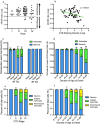Chronic traumatic encephalopathy (CTE): criteria for neuropathological diagnosis and relationship to repetitive head impacts
- PMID: 36759368
- PMCID: PMC10020327
- DOI: 10.1007/s00401-023-02540-w
Chronic traumatic encephalopathy (CTE): criteria for neuropathological diagnosis and relationship to repetitive head impacts
Abstract
Over the last 17 years, there has been a remarkable increase in scientific research concerning chronic traumatic encephalopathy (CTE). Since the publication of NINDS-NIBIB criteria for the neuropathological diagnosis of CTE in 2016, and diagnostic refinements in 2021, hundreds of contact sport athletes and others have been diagnosed at postmortem examination with CTE. CTE has been reported in amateur and professional athletes, including a bull rider, boxers, wrestlers, and American, Canadian, and Australian rules football, rugby union, rugby league, soccer, and ice hockey players. The pathology of CTE is unique, characterized by a pathognomonic lesion consisting of a perivascular accumulation of neuronal phosphorylated tau (p-tau) variably alongside astrocytic aggregates at the depths of the cortical sulci, and a distinctive molecular structural configuration of p-tau fibrils that is unlike the changes observed with aging, Alzheimer's disease, or any other tauopathy. Computational 3-D and finite element models predict the perivascular and sulcal location of p-tau pathology as these brain regions undergo the greatest mechanical deformation during head impact injury. Presently, CTE can be definitively diagnosed only by postmortem neuropathological examination; the corresponding clinical condition is known as traumatic encephalopathy syndrome (TES). Over 97% of CTE cases published have been reported in individuals with known exposure to repetitive head impacts (RHI), including concussions and nonconcussive impacts, most often experienced through participation in contact sports. While some suggest there is uncertainty whether a causal relationship exists between RHI and CTE, the preponderance of the evidence suggests a high likelihood of a causal relationship, a conclusion that is strengthened by the absence of any evidence for plausible alternative hypotheses. There is a robust dose-response relationship between CTE and years of American football play, a relationship that remains consistent even when rigorously accounting for selection bias. Furthermore, a recent study suggests that selection bias underestimates the observed risk. Here, we present the advances in the neuropathological diagnosis of CTE culminating with the development of the NINDS-NIBIB criteria, the multiple international studies that have used these criteria to report CTE in hundreds of contact sports players and others, and the evidence for a robust dose-response relationship between RHI and CTE.
Keywords: CTE; Neurodegeneration; Repetitive head impacts; Tauopathy.
© 2023. The Author(s).
Conflict of interest statement
The authors have no relevant financial or non-financial interests to disclose.
Figures





References
-
- Abdolmohammadi B, Uretsky M, Nair E, Saltiel N, Nicks R, Daneshvar D et al (2022) Duration of ice hockey play and chronic traumatic encephalopathy risk (P1–1.Virtual). Neurology 98:3026
Publication types
MeSH terms
Substances
Grants and funding
- R01 NS119651/NS/NINDS NIH HHS/United States
- U01 NS086659/NS/NINDS NIH HHS/United States
- R01 AG062348/AG/NIA NIH HHS/United States
- K23 NS102399/NS/NINDS NIH HHS/United States
- U54 NS115266/NS/NINDS NIH HHS/United States
- IK2 BX004349/BX/BLRD VA/United States
- K01 AG070326/AG/NIA NIH HHS/United States
- P30 AG066546/AG/NIA NIH HHS/United States
- P30 AG013846/AG/NIA NIH HHS/United States
- I01 BX002466/BX/BLRD VA/United States
- P30 AG072978/AG/NIA NIH HHS/United States
- I01 BX004613/BX/BLRD VA/United States
- RF1 NS095252/NS/NINDS NIH HHS/United States
- RF1 AG057902/AG/NIA NIH HHS/United States
LinkOut - more resources
Full Text Sources

